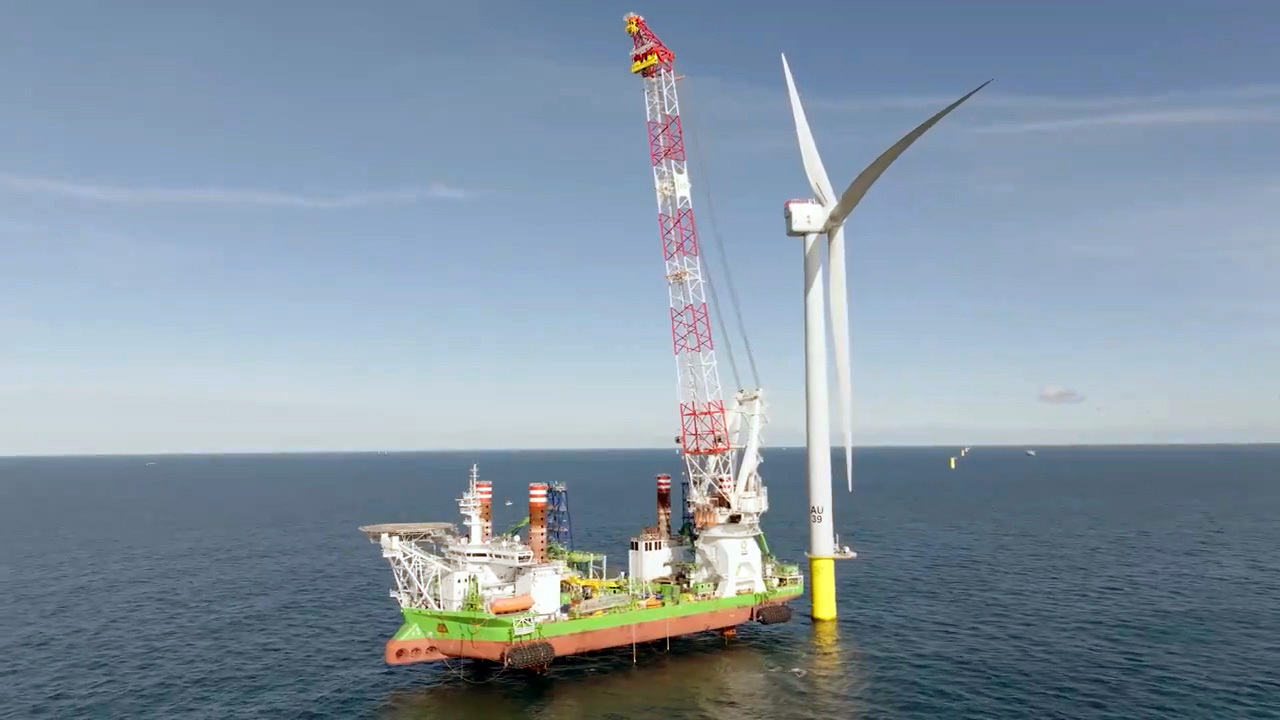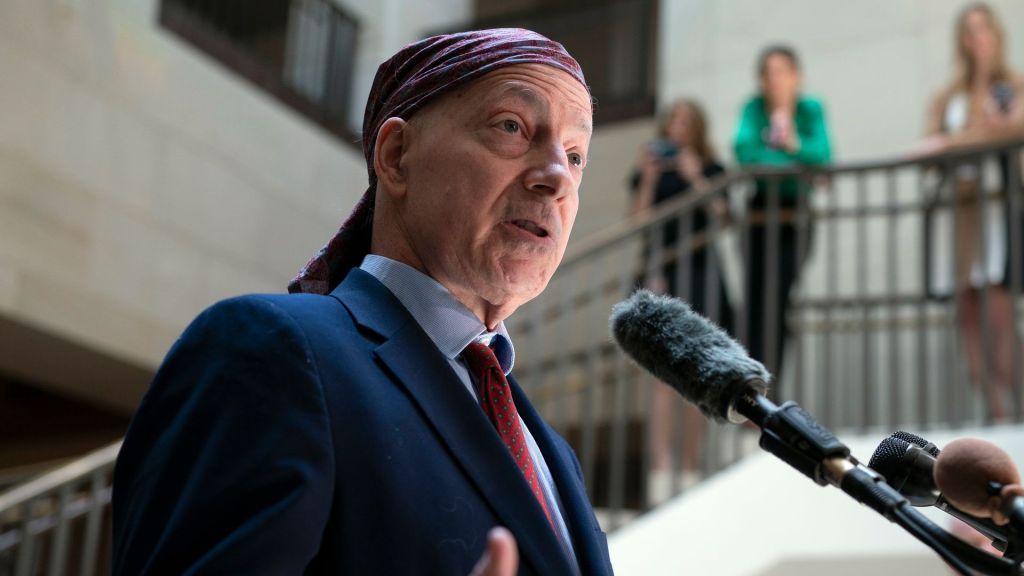
[JACK AYLMER]
IT’S THE FIRST LARGE SCALE OFFSHORE WIND FARM IN THE UNITED STATES.
LOCATED 14 MILES OFF THE COAST OF MARTHA’S VINEYARD, MASSACHUSETTS, THE PROJECT IS NOW OFFICIALLY UP AND RUNNING.
DUBBED VINEYARD WIND ONE, JUST A FRACTION OF ITS PLANNED 62 TURBINES ARE CURRENTLY OPERATIONAL.
JUST 5 TURBINES ARE ENOUGH TO GENERATE A CONSIDERABLE AMOUNT OF ENERGY, WITH THE ABILITY TO POWER ABOUT 30,000 HOMES.
ONCE ALL THE TURBINES ARE ONLINE, THE WIND FARM IS EXPECTED TO PRODUCE ELECTRICITY FOR AROUND 400,000 HOMES.
STATE OFFICIALS HAVE PRAISED THIS DEVELOPMENT AS A TURNING POINT IN THE CLEAN ENERGY TRANSITION.
BUT, ELSEWHERE, MOMENTUM HAS SLOWED ON A NUMBER OF OFFSHORE WIND PROJECTS.
2023 SAW SEVERAL ALONG THE EAST COAST FACE DELAYS OR CANCELLATIONS.
ORSTED SCRAPPED A PAIR OF PLANNED OFFSHORE WIND FARMS IN SOUTHERN NEW JERSEY.
THE DANISH ENERGY COMPANY CHOSE TO INCUR A POTENTIAL $300 MILLION PENALTY FOR BACKING OUT RATHER THAN BUILD THE PROJECT.
A SIMILAR THING HAPPENED IN BOTH MASSACHUSETTS AND CONNECTICUT.
OFFSHORE WIND DEVELOPERS OF THREE PLANNED PROJECTS IN THOSE STATES DECIDED TO PAY OUT A TOTAL OF $124 MILLION TO GET OUT OF THEIR CONTRACTS.
NEW YORK ALSO HAD TROUBLE GETTING ENERGY COMPANIES TO STICK TO THEIR ORIGINAL WIND FARM LEASES.
FACED WITH MOUNTING COSTS, DEVELOPERS LOBBIED THE STATE TO MAKE ITS CONSUMERS TAKE ON AS MUCH AS A 65% INCREASE ON THEIR ELECTRICITY BILLS TO MAKE THE PROJECT WORK.
IN TOTAL, THESE CANCELED INITIATIVES ACCOUNTED FOR MORE THAN A FIFTH OF THE POWER THAT THE BIDEN ADMINISTRATION HAD BEEN HOPING TO PRODUCE FROM OFFSHORE WIND FARMS BY 2030.
GLOBAL INFLATION PRESSURE HAS BEEN A BIG FACTOR, CAUSING DEVELOPERS TO REALIZE THEIR PROJECTS ARE NO LONGER PROFITABLE AS A RESULT OF RISING MATERIAL COSTS.
THE AVERAGE PRICE OF THE SEVEN MOST SIGNIFICANT CRITICAL MINERALS FOR THE WIND INDUSTRY HAS INCREASED BY 93% SINCE JANUARY 2020.
OVERALL, THE COST OF BUILDING A TURBINE HAS JUMPED NEARLY 40% OVER THE LAST TWO YEARS.
THIS FORCED ENERGY COMPANIES LIKE EQUINOR, BP AND ORSTED TO TAKE A COMBINED $5 BILLION IN VALUE REDUCTION IN 2023 ON U.S. OFFSHORE WIND DEVELOPMENTS.
DESPITE THE STALLED PROGRESS AND INCREASED COSTS LAST YEAR, THE INDUSTRY IS STILL OPTIMISTIC THE WINDS WILL SHIFT IN 2024.
DEVELOPERS HOPE THAT MORE FORGIVING CONTRACT TERMS WILL HELP REVIVE SOME OF THOSE PREVIOUSLY CANCELED PROJECTS.
NEW YORK HAS ALLOWED ENERGY COMPANIES TO CANCEL CONTRACTS THAT HAVE BECOME NO LONGER FINANCIALLY VIABLE AT NO COST –
PROVIDED THEY PARTICIPATED IN A SUBSEQUENT AUCTION FOR MORE OFFSHORE WIND LEASES.
CONNECTICUT IS ALLOWING OFFSHORE LEASE BIDDERS THE OPTION TO INCREASE ITS PROJECTED ENERGY PRICES BY AS MUCH AS 15% SHOULD ECONOMIC CHANGES MAKE IT NECESSARY.
SOME STATES ARE ALSO OFFERING REDUCED BID FEES ON POSSIBLE PROJECT SITES.
THESE INCENTIVES ARE ALL ON TOP OF THE FEDERAL GOVERNMENT’S EXISTING TAX BREAKS FOR OFFSHORE WIND, PART OF PRESIDENT BIDEN’S PUSH FOR INCREASED RENEWABLE ENERGY PRODUCTION.
IF THE WHITE HOUSE HOPES TO SEE IT’S GOAL OF 10 MILLION HOMES POWERED BY THIS TECHNOLOGY IN 2030 REALIZED, THEY’LL NEED THIS YEAR TO MARK A TURNAROUND FOR THE INDUSTRY.
VINEYARD WIND 1 IS A POSITIVE STEP TOWARDS THIS, BUT MORE WILL NEED TO FOLLOW.







